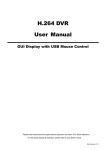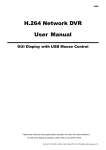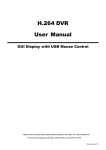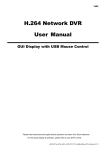Download DIGITAL VIDEO RECORDER
Transcript
DIGITAL VIDEO RECORDER USER MANUAL Please read instructions thoroughly before operation and retain it for future reference. KD673_672_671_670_AC791_790_CD540_MR673_manual_V1.2 IMPORTANT SAFEGUARD CAUTION RISK OF ELECTRIC SHOCK CAUTION: To reduce the risk of electric shock, do not expose this apparatus to rain or moisture. Only operate this apparatus from the type of power source indicated on the label. The company shall not be liable for any damages arising out of any improper use, even if we have been advised of the possibility of such damages. The lightning flash with arrowhead symbol, within an equilateral triangle, is intended to alert the user to the presence of uninsulated “dangerous voltage” within the product’s enclosure that may be of sufficient magnitude to constitute a risk of electric shock to persons. This exclamation point within an equilateral triangle is intended to alert the user to the presence of important operating and maintenance (servicing) instructions in the literature accompanying the appliance. All lead-free products offered by the company comply with the requirements of the European law on the Restriction of Hazardous Substances (RoHS) directive, which means our manufacture processes and products are strictly “lead-free” and without the hazardous substances cited in the directive. The crossed-out wheeled bin mark symbolizes that within the European Union the product must be collected separately at the product end-of-life. This applies to your product and any peripherals marked with this symbol. Do not dispose of these products as unsorted municipal waste. Contact your local dealer for procedures for recycling this equipment. This apparatus is manufactured to comply with the radio interference requirements. Disclaimer The information in this manual was current when released. We reserve the right to revise or remove any content in this manual at any time. We do not warrant or assume any legal liability or responsibility for the accuracy, completeness, or usefulness of this manual. For the actual display & operation, please refer to your DVR in hand. The content of this manual is subject to change without notice. The product & company names mentioned herein may be the registered trademarks or tradenames of their respective owners. Grounding This is a Safety Class 1 Product (provided with a protective earthing ground incorporated in the power cord). The mains plug shall only be inserted in a socket outlet provided with a protective earth contact. Any interruption of the protective conductor inside or outside of the instrument is likely to make the instrument dangerous. Intentional interruption is prohibited. Water & Moisture Do not expose this product to dripping or splashing and that no objects filled with liquids, such as vases, shall be placed on the product. MPEG4 Licensing THIS PRODUCT IS LICENSED UNDER THE MPEG-4 VISUAL PATENT PORTFOLIO LICENSE FOR THE PERSONAL AND NON-COMMERCIAL USE OF A CONSUMER FOR (i) ENCODING VIDEO IN COMPLIANCE WITH THE MPEG-4 VISUAL STANDARD (“MPEG-4 VIDEO”) AND/OR (ii) DECODING MPEG-4 VIDEO THAT WAS ENCODED BY A CONSUMER ENGAGED IN A PERSONAL AND NON-COMMERCIAL ACTIVITY AND/OR WAS OBTAINED FROM A VIDEO PROVIDER LICENSED BY MPEG LA TO PROVIDE MPEG-4 VIDEO. NO LICENSE IS GRANTED OR SHALL BE IMPLIED FOR ANY OTHER USE. ADDITIONAL INFORMATION INCLUDING THAT RELATING TO PROMOTIONAL INTERNAL AND COMMERCIAL USES AND LICENSING MAY BE OBTAINED FROM MPEG LA, LLC. SEE HTTP://WWW.MPEGLA.COM. GPL Licensing This product contains codes which are developed by Third-Party-Companies and which are subject to the GNU General Public License (“GPL”) or the GNU Lesser Public License (“LGPL”). The GPL Code used in this product is released without warranty and is subject to the copyright of the corresponding author. Further source codes which are subject to the GPL-licenses are available upon request. We are pleased to provide our modifications to the Linux Kernel, as well as a few new commands, and some tools to get you into the code. The codes are provided on the FTP site, and please download them from the following site or you can refer to your distributor: ftp://ftp.dvrtw.com.tw/GPL/AV074/ Version Firmware: 1112-1036-1013-1024-0a-0000 Video Viewer: 0119 TABLE OF CONTENTS 1. SPECIAL NOTES ..................................................................................................................................................................................................... 1 2. FRONT AND REAR PANEL...................................................................................................................................................................................... 2 2.1. Front Panel ..................................................................................................................................................................................................... 2 2.2. Rear Panel...................................................................................................................................................................................................... 3 3. CONNECTION AND SETUP .................................................................................................................................................................................... 4 3.1. HDD Installation.............................................................................................................................................................................................. 4 3.2. Camera Connection........................................................................................................................................................................................ 5 3.3. Optional Peripheral Connection (Selected models only)................................................................................................................................ 5 3.4. Power Setup ................................................................................................................................................................................................... 5 3.5. Date and Time Setting .................................................................................................................................................................................... 5 3.6. Password Setting............................................................................................................................................................................................ 5 3.7. Record Setting................................................................................................................................................................................................ 6 4. BASIC OPERATION ................................................................................................................................................................................................. 7 4.1 Live Page......................................................................................................................................................................................................... 7 4.2. Recording ....................................................................................................................................................................................................... 7 4.3. Playback ......................................................................................................................................................................................................... 8 4.4. Search ............................................................................................................................................................................................................ 8 4.5. Firmware / OSD Upgrade ............................................................................................................................................................................... 9 5. ADVANCED OPERATION ...................................................................................................................................................................................... 10 5.1. QUICK SEARCH .......................................................................................................................................................................................... 10 5.2. RECORD ...................................................................................................................................................................................................... 10 5.2.1. Quick record setting ........................................................................................................................................................................... 10 5.2.2. Detailed record setting ....................................................................................................................................................................... 10 5.3. TIMER........................................................................................................................................................................................................... 11 5.4. DETECTION................................................................................................................................................................................................. 12 5.5. REMOTE (Selected models only) ................................................................................................................................................................ 14 5.6. SYSTEM INFO ............................................................................................................................................................................................. 14 5.7. NETWORK (Selected models only) ............................................................................................................................................................. 15 5.7.1. STATIC ............................................................................................................................................................................................... 15 5.7.2. PPPOE ............................................................................................................................................................................................... 15 5.7.3. DHCP ................................................................................................................................................................................................. 16 5.8. BACKUP ....................................................................................................................................................................................................... 17 5.8.1. USB BACKUP .................................................................................................................................................................................... 17 6. REMOTE OPERATION .......................................................................................................................................................................................... 19 6.1. Video Viewer................................................................................................................................................................................................. 19 6.1.1. Installation & Network Connection ..................................................................................................................................................... 19 6.1.2. Control Panel...................................................................................................................................................................................... 20 6.1.3. General Operation.............................................................................................................................................................................. 22 6.1.4. E-Map................................................................................................................................................................................................. 24 6.2. IE Web Browser............................................................................................................................................................................................ 29 6.3. QuickTime Player ......................................................................................................................................................................................... 31 APPENDIX 1 PIN CONFIGURATION (Selected models only)................................................................................................................................... 32 APPENDIX 2 TROUBLESHOOTING ......................................................................................................................................................................... 33 APPENDIX 3 COMPATIBLE USB FLASH DRIVE LIST ............................................................................................................................................. 34 APPENDIX 4 COMPATIBLE SATA HDD LIST............................................................................................................................................................ 35 APPENDIX 5 SPECIFICATIONS................................................................................................................................................................................ 36 APPENDIX 6 RS485 PROTOCOL ............................................................................................................................................................................. 38 APPENDIX 7 RECORDING TIME TABLE.................................................................................................................................................................. 39 APPENDIX 8 DVR BATTERY REPLACEMENT......................................................................................................................................................... 40 SPECIAL NOTES 1. SPECIAL NOTES VGA Output Resolution Support Model 1 and Model 2 have VGA interface built-in, and users are allowed to change the resolution depending on their display monitor. Go to “ADVANCE” “DISPLAY”, and move to “VGA OUTPUT” to select the VGA resolution you want. There are seven options as follows: 1) 800 x 600 2) 1024 x 768 (default) 3) 1280 x 1024 4) 1440 x 900 5) 1400 x 1050 6) 1680 x 1050 7) 1600 x 1200 Note: To have the best image quality on your LCD monitor, make sure (1) the selected DVR VGA output resolution is supported by your monitor, and (2) the VGA output settings on both the LCD monitor and DVR are consistent. If the image is not positioned or scaled properly, please go to your monitor’s menu for adjustment. For details, please refer to the user manual of your LCD monitor. Power Supply To ensure that your DVR works constantly and properly, it's recommended to use an UPS, Uninterruptible Power Supply, for continuously operation. (Optional) 1 FRONT AND REAR PANEL 2. FRONT AND REAR PANEL 2.1. Front Panel 1) LED Indicators POWER : DVR is powered on. HDD : HDD is reading or recording. ALARM TIMER PLAY : An alarm is triggered (Selected models only). : Timer recording is on. : Under playback status. 2) MENU Press to enter the main menu. 3) ENTER Press to confirm the setting. 4) LIST To quickly search the recorded files by event, press to show the event list. Select one event, and press “ENTER” to playback the selected file. 5) PLAY Press to play the recorded video. 6) SLOW Under the playback mode, press to slowly playback the recorded file. 7) ZOOM In the live or playback mode, press to enlarge the image of the selected channel. 8) SEQ Press to activate the call monitor function, and press again to quit. 9) Press to show the four-channel display mode. 10) POWER Press long enough to turn on/off your DVR. Note: Under the recording mode, please stop recording before turning off your DVR. Note: To ensure that your DVR works constantly and properly, it's recommended to use an UPS, Uninterruptible Power Supply, for continuously operation. (Optional) 11) 1~4 Press one of the buttons to select the channel to display. 12) ( / +) / ( / -) / () / () Press one of these four buttons to move up/down/left/right. Under the playback mode, press these buttons to pause () / stop () / fast rewind () / fast forward () the playback file. Under the setting mode, press / to change the setting in the menu. 13) AUDIO (SLOW + ZOOM) Press “SLOW” + “ZOOM” at the same time to select live or playback sounds of the audio channels. 14) PTZ (SEQ + Press “SEQ” + “ ) (Selected models only) ” at the same time to enter / exit the PTZ control mode. 2 FRONT AND REAR PANEL Adjust PTZ angle: Press / / / to turn up/down/left/right. 15) USB port To quickly backup or upgrade firmware/OSD, you can insert a compatible USB flash drive into this USB port. Before using the USB flash drive, please use your PC to format the USB flash drive as “FAT32” first. 2.2. Rear Panel 1) VIDEO INPUT (1 ~ 4) Connect to video sources, such as cameras. Note: If you want to make a video backup with audio, please make sure whether your DVR supports the audio function, and connect audio cameras to the channels which support the audio function. 2) VIDEO OUTPUT Connect to a CRT monitor for video output. 3) AUDIO IN (Select models only) Connect to audio sources, such as cameras equipped with the audio function. Please get to know whether your DVR supports the audio function, and how many audio inputs are supported first. Note: Depending on the model you have, this DVR series supports UP TO FOUR audio-in channels, which are Audio 1, Audio 2, Audio 3 and Audio 4 accordingly, and the audio data will be recorded with the video data of CH1, CH2, CH3 and CH4 respectively. For example, if your DVR supports two audio-in, its audio channels will be Audio 1 and Audio 2. When you playback CH1, you will also hear the audio recording of Audio 1. 4) AUDIO OUT (Selected models only) Connect to an audio device, such as a microphone or speaker. 5) IR (Selected models only) Connect the IR receiver (optional) for remote control. 6) EXTERNAL I/O (Selected models only) Insert the supplied 9PIN DSUB to this port for connecting external devices (external alarm, PTZ camera, etc). For detailed I/O port PIN configuration, please refer to “APPENDIX 1 PIN CONFIGURATION (Selected models only)” at page 32. 7) VGA (Selected models only) Connect to a LCD monitor directly. 8) LAN (Selected models only) Connect to Internet by LAN cable. 9) DC 19V Connect to the supplied adapter. 3 CONNECTION AND SETUP 3. CONNECTION AND SETUP Note: The DVR is designed to automatically detect the video system of the connected cameras (NTSC or PAL). To make sure the system detection is correct, please check if the cameras are connected to the DVR and power-supplied before the DVR is powered on. 3.1. HDD Installation The HDD must be installed before the DVR is turned on. Step 1: Loose the screws on the upper cover and remove it from the DVR. Find the two HDD brackets located on the DVR base as indicated below. Step 2: Get a compatible HDD, and connect it to the power connector and data bus connector. Step 3: Make sure the PCB side is facing up, and place the HDD between the HDD brackets on the DVR base as shown below. Make sure the other side of the HDD is contacted with the DVR base for heat conduction. Step 4: Align the screw hole on the each bracket with the screw hole on the each side of the HDD as shown below, and fix the HDD to the bracket with a HDD screw supplied. Step 5: Close the upper cover of the DVR, and fasten all the screws you loosened in Step 1. 4 CONNECTION AND SETUP 3.2. Camera Connection The cameras must be connected and power-supplied. And then connect the camera video output to the DVR video input port with a coaxial cable or RCA lines with BNC connectors. The DVR will automatically detect the video system of the connected camera(s) (NTSC / PAL), and switch itself to the correct system. 1) Power connection Connect the camera with indicated power supply. 2) Video cable connection Connect the camera video output to the DVR video input port with a coaxial cable or RCA line with BNC connector. 3) Audio cable connection (Selected models only) Connect the camera audio output to the DVR audio input port with a coaxial cable or RCA line with BNC connector. 4) Camera Setup (PTZ cameras only) For detailed camera title, ID, protocol and baud rate setup, please refer to “5.5. REMOTE” at page 14. 3.3. Optional Peripheral Connection (Selected models only) Depending on the DVR model you have, this DVR series may support to connect other peripherals. For detailed connection, please refer to their own user manuals. 3.4. Power Setup This device should be operated only with the type of power source indicated on the manufacturer’s label. Connect the indicated AC power cord to the power adapter, and plug into an electrical outlet. The power LED will be on. Note: To ensure that your DVR works constantly and properly, it's recommended to use an UPS, Uninterruptible Power Supply, for continuously operation. (Optional) 3.5. Date and Time Setting Before operating your DVR, please set the date and time on your DVR first. Press “MENU” and enter the password to go to the menu list. The default admin password is 0000. Move to “DATE” and you can set the date / time / daylight saving in the “DATE” menu list. Note: Please DO NOT change the date or time of your DVR after the recording function is activated. Otherwise, the recorded data will be disordered and you will not be able to find the recorded file to backup by time search. If users change the date or time accidentally when the recording function is activated, it’s recommended to clear all HDD data, and start recording again. Note: For the first time to use the DVR, please power it on for at least 48 hours continuously after the date & time is set correctly. It helps to prevent DVR time from resetting after the disconnecting of DVR power. If the DVR time resets after the disconnecting of DVR power, for example, caused by a power outage, the battery might run out and please replace the battery as described in “APPENDIX 8 DVR BATTERY REPLACEMENT” at page 40. 3.6. Password Setting Press “MENU” and enter the password to go to the menu list. Then, Move to “ADVANCE” to enter the advanced setting menu. In the “ADVANCE” menu, move to “SYSTEM INFO”. Select “PASSWORD” and press “ENTER” to enter the 5 CONNECTION AND SETUP submenu to set the password (four digits). The default admin password is 0000. 3.7. Record Setting By defaults, the record function is activated when the DVR is powered on and a camera is connected. To change the record settings, Press “MENU” and enter the password to go to the menu list. Then, Move to “RECORD” to enter the advanced setting menu. For details, please refer to “5.2. RECORD” at page 10. 6 BASIC OPERATION 4. BASIC OPERATION 4.1 Live Page Depending on the DVR you have, you may see the following live view screen with status icons. Icon Function Icon Function Icon Function Icon Function Key lock Key unlock 1st live audio channel 2nd live audio channel 3rd live audio channel 4th live audio channel 1st playback audio channel 2nd playback audio channel 3rd playback audio channel 4th playback audio channel Audio channel unselected Digital zoom mode Digital zoom unselected HDD overwrite Timer recording Motion Recording Alarm (Selected models only) 4.2. Recording When the recording and the pre-alarm function are activated, this device will overwrite 8GB data from the oldest for continuous recording without notice. 1) Manual Recording Icon By defaults, when the DVR is properly connected with cameras and the HDD is installed, you can see “ (recording) on the screen. 2) Event Recording Icon When the motion / alarm detection is activated, once motion or external alarm happens, you will see “ or “ ” (external alarm) on the screen. 3) ” ” (motion) Timer Recording Icon When the timer record is activated, you will see the LED light of “Timer” is on, and “ 7 ” (timer) on the screen. BASIC OPERATION 4.3. Playback Press “PLAY” on the DVR control panel, and the device will playback the latest recorded video. Note: There must be at least 8192 images of recorded data for playback to work properly. If not, the device will stop playback. For example, if the IPS is set to 30, the recording time should be at least 273 seconds (8192 images / 30 IPS) for the playback to work properly. 1) Fast Forward / Fast Rewind You can increase the speed for fast forward and rewind on this device. In the playback mode: Press ““ once to get 4X speed forward and press twice to get 8X speed, etc. And the maximum speed is 32X. Press ““ once to get 4X speed rewind and press twice to get 8X speed, etc. And the maximum speed is 32X. Note: During playback, the image size of the recorded data (FRAME, FIELD or CIF) will be shown on the screen. 2) Pause / Image Jog Press “” to pause the playback. In the pause mode: Press “” once to get one frame forward. Press “” once to get one frame rewind. 3) Stop Press “” under the playback mode, and the screen of this device will return to live monitoring mode. 4) Slow Playback Press “SLOW” to get 1/4X speed playback and press twice to get 1/8X speed playback. 5) Audio Playback (Selected models only) Press “SEQ” + “ ” to select the live or playback sound of the audio channels. Live audio of the 1st audio channel Playback audio of the 1st audio channel Live audio of the 2nd audio channel Playback audio of the 2nd audio channel Live audio of the 3rd audio channel Playback audio of the 3rd audio channel Live audio of the 4th audio channel Playback audio of the 4th audio channel The audio channel is not selected. Note: Depending on the model you have, this DVR series supports UP TO FOUR audio-in channels, which are Audio 1, Audio 2, Audio 3 and Audio 4 accordingly, and the audio data will be recorded with the video data of CH1, CH2, CH3 and CH4 respectively. For example, if your DVR supports two audio-in, its audio channels will be Audio 1 and Audio 2. When you playback CH1, you will also hear the audio recording of Audio 1. 4.4. Search 1) Full Event Search Press “LIST” to show the recorded files by event. Choose the item you want to see, and press “ENTER” to start playback. 2) Search by Time Press “MENU” to enter the menu list, and go to “ADVANCE” “EVENT LOG”. Move to “QUICK SEARCH”, and press “ENTER” to enter the quick time search menu. You can search any specific events by time (Year / Month / Day / Hour / Min) and directly play the file you find. 8 BASIC OPERATION 4.5. Firmware / OSD Upgrade 1) By using USB flash drive Step 1. Format the USB memory device as FAT32 format first. Step 2. Get the upgrade files from your distributor and save the upgrade files in your USB flash device (do not change the file name). Step 3. Insert the USB flash drive into the DVR USB port. Step 4. Press “MENU”, move to “ADVANCE” “SYSTEM INFO”, and move to “UPGRADE”. Press “ENTER”. Step 5. Select “YES”, and press “ENTER” again to confirm upgrade. 2) By using the supplied software “Video Viewer” Step 1. Save the upgrade files at your PC (do not change the file name), and execute Video Viewer. Step 2. In the “Address Book” panel, select the IP address of your DVR (or add the IP address of your DVR to the address book if it’s not yet in the address book), and click “ ” to show the “Update Server” panel. Step 3. In “Update Server”, click “Firmware” or “Language” tab as needed, and click “Add” to select the firmware or OSD files to upgrade. Step 4. Click “Update Firmware” or “Update Language” to start the upgrade. 9 ADVANCED OPERATION 5. ADVANCED OPERATION 5.1. QUICK SEARCH You can search any specific events by time and directly play the file you find from the DVR. Move to “QUICK SEARCH”, and press “ENTER”. You will see the following submenu items: 1) DATE Select the specific time period (YEAR / MONTH / DAY / HOUR / MIN) that you want to search. 2) SEARCH HDD Change to the HDD you want if there are more than 1 HDD in your DVR. 3) START Move to “START” and press “ENTER” button to search and directly playback the recorded files. 5.2. RECORD In this menu list, you can set record settings. Press “MENU” on the front panel. The default admin password is 0000. Enter the default password, and press “ENTER”. 5.2.1. Quick record setting Move to “QUICK START” J “RECORD”. The screen will show the following submenu items: 1) IMAGE SIZE Select FRAME, FIELD (Selected models only) or CIF. 2) QUALITY Select one of the four quality options: SUPER BEST, BEST, HIGH & NORMAL. 3) IMAGE PER SECOND Select the images per second for MANUAL RECORD. 5.2.2. Detailed record setting Move to “ADVANCE” J “RECORD”, and press ”ENTER”. The screen will show the following submenu items: 1) MANUAL RECORD ENABLE Start / stop the manual recording function. 2) EVENT RECORD ENABLE Start / stop the event recording function. When this function is enabled, the recording will be triggered by any motion or external alarm. 3) TIMER RECORD ENABLE Start / stop the timer recording that is activated according to the scheduled time 4) EVENT RECORD IPS Select the images per second for EVENT RECORD (Recording that is triggered by alarm or motion). 5) TIMER RECORD IPS Select the images per second for TIMER RECORD (Recording that is activated according to the scheduled time.). 10 ADVANCED OPERATION 6) PRE-ALARM RECORD Select to enable or disable the pre-alarm function (ON / OFF). When pre-alarm and event recording functions are both activated, the DVR will record 8MB data before an alarm / motion event is triggered. 7) OVERWRITE Select to overwrite previous recorded data in your HDD. When the HDD is full under the O/W recording mode, the DVR will clear 8GB data from the oldest for continuous recording without notice. 5.3. TIMER In this menu list, you can schedule different sets of time for recording and detection function. Move to “TIMER”, and press ”ENTER”. Select to enable (ON) or disable (OFF) the recorder timer and / or detection timer functions. 1) RECORD TIMER Use / to change the setting (ON / OFF). When it’s set to “ON”, press “ENTER” to go to its submenu for further settings. RECORD TIMER 0 2 4 6 8 10 12 14 16 18 20 22 24 SUN MON TUE WED THU FRI SAT PLEASE CONSULT YOUR INSTALLER FOR ADVANCE SETTINGS uv s t MOVE SELECT X axis Y axis Operation 0 ~ 24 hours. Each time interval within a square is two hours (divided into four 30-minutes). Monday ~ Sunday. Move to the start time point, and press enter to set the start time point (marked in red color). Then, press / / / to set the timer-recording schedule. After setup, press “ENTER” again to create an ending time point (marked in yellow color) and press “MENU” to exit. 11 ADVANCED OPERATION 2) DETECTION TIMER Use / to change the setting (ON / OFF). When it’s set to “ON”, press “ENTER” to go to its submenu for further settings. DETECTION TIMER 0 2 4 6 8 10 12 14 16 18 20 22 24 SUN MON TUE WED THU FRI SAT PLEASE CONSULT YOUR INSTALLER FOR ADVANCE SETTINGS uv s t MOVE SELECT X axis Y axis Operation 0 ~ 24 hours. Each time interval within a square is two hours (divided into four 30-minutes). Monday ~ Sunday. Move to the start time point, and press enter to set the start time point (marked in red color). Then, press / / / to set the timer-recording schedule. After setup, press “ENTER” again to create an ending time point (marked in yellow color) and press “MENU” to exit. Note: This function here is only for detection timer setup and activation. 5.4. DETECTION In this submenu, you can set up detection-related functions. Move to “DETECTION”, and press ”ENTER”. The screen will show the following submenu items: 1) TITLE Show the camera title of each channel set in “CAMERA”. 2) DET 3) The available options vary depending on the model you have. For Model 1 & 2: Select if you want to activate the motion detection function for the selected channel (ON/OFF). For Model 3 & 4: Select HIGH / NORMAL / LOW to activate the motion detection function with different sensitivity for the selected channel, or select OFF to disable this function. AREA Press “ENTER” to set the detection area. You will see similar screens as the following: Pink blocks represent the area that is not being detected while the transparent blocks are the area under detection. There are two different methods to set the detection area depending on the model you have. 12 ADVANCED OPERATION Model 1 & 2 Transparent blocks are the area under detection. Press / to choose the height of the area. Press “ENTER” to confirm the start area. Press / to choose the width of the detection area. You can also set up multi-detection area. When any movement is detected, you will see the grids are flashing. *Pink blocks represent the area that is not being detected while the transparent blocks are the area under detection. Model 3 & 4 *Pink blocks represent the area that is not being detected while the transparent blocks are the area under detection. There are three detection areas for your choice: Press “” or ” ” once to broaden the detection area. Press “” or ” ” once to narrow the detection area. 4) LS (Level of Sensitivity) (Selected models only) “LS” is to set the sensitivity of comparing two different images. The smaller the value is, the higher sensitivity for motion detection. 5) SS (Spatial Sensitivity) (Selected models only) “SS” is to set the sensitivity for detecting the size of one object (the number of the grids) on the screen. The smaller the value is, the higher sensitivity for motion detection. Note: The default setting of SS is 03, which means once an object is detected more than 3 grids, the system will get triggered. So the value of SS must be less than the number of grids that you set up for the motion detection area. 6) TS (Time of Sensitivity) (Selected models only) “TS” is to set the sensitivity regarding how long one object stays in the detection area and triggers the recording. Depending on the model you have, you may see either of the following methods: a). Select a value -- The smaller the value is, the higher sensitivity for motion detection. b). Select an option – HIGH / NORMAL. 7) RE (Reference) (Selected models only) “RE” is to set a reference for detection. The default value is 10, which means the DVR will compare 10 continuous images at one time according to the sensitivity of LS, SS, TS simultaneously. 13 ADVANCED OPERATION 8) ALARM (Selected models only) Select N.C. (Normally Closed) / N.O. (Normally open) / OFF for the alarm polarity. The default alarm value is OFF. 5.5. REMOTE (Selected models only) In this menu list, you can set up remote devices to work properly. Move to “REMOTE”, and press ”ENTER”. You will see the following submenu items: 1) TITLE Show the camera title of each channel set in “CAMERA”. 2) DEVICE Select the device type (CAMERA / PTZ) according to the connected camera for each channel. 3) ID Set the ID number (0 ~ 255) for a PTZ camera. After connecting to a PTZ camera correctly, the default ID of the PTZ camera will be shown on the screen. 4) PROTOCOL Select NORMAL (our protocol), P-D (PELCO-D) or P-P (PELCO-P) protocol. 5) RATE Set the baud rate of each channel (2400 / 4800 / 9600 / 19200 / 57600 / 115200). For the connected cameras, such as PTZ and speed dome cameras, etc., please make sure their baud rate setting is the same as the setting here. 5.6. SYSTEM INFO In this menu list, you can check or change some system settings. The submenu items are described below: 1) SERIAL TYPE (Selected models only) Show the serial type of the DVR (RS485). 2) BAUDRATE (Selected models only) Set the baud rate of the DVR (2400 / 9600 / 19200 / 38400 / 57600 / 115200). 3) HOST ID (Selected models only) Set the ID of the DVR (0 ~ 254). 4) PASSWORD Press “ENTER” to reset the password for accessing the DVR system. You can set the password up to 4 digits. 5) RESET DEFAULT Press “ENTER” to reset all settings as default, and select “YES” to confirm or “NO” to cancel. 6) CLEAR HDD Select the HDD you want to clear. Press “ENTER”, and select “YES” to confirm to clear HDD or “NO” to cancel. 7) UPGRADE Before using the USB flash drive, please use your PC to format the USB flash drive as FAT32 format first. Then, save the upgrade file in a compatible USB flash drive, and insert it into the USB port at the front panel. Press “ENTER”, and select “YES” to confirm upgrade or “NO” to cancel. Note: To use this function, you need to have the upgrade file saved in a compatible USB flash drive, and insert it into the USB port at the front. 14 ADVANCED OPERATION Note: Do not disconnect the power of your DVR while the upgrade process is in progress, or the DVR functions may not work normally or be unable to use. 8) AUTO KEYLOCK (SEC) Set the time-out in second after which the key lock function is activated (NEVER / 30 / 60 / 120). 9) LANGUAGE Select the language of the OSD. 10) VIDEO FORMAT Here shows the information of the DVR video format (NTSC / PAL). 11) VERSION Here shows the firmware version information. 5.7. NETWORK (Selected models only) In this menu list, you can set up the network. Move to “NETWORK”, and press “ENTER” to enter the submenu. The submenu items are described below. 5.7.1. STATIC 1) NETWORK TYPE Select the network type as STATIC and set all the information needed in the DVR. 2) NETWORK INFORMATION (IP / GATEWAY / NETMASK) Key in all the network information obtained from your ISP (Internet Service Provider). 3) DNS (PRIMARY DNS / SECONDARY DNS) Key in the IP address of the domain name server obtained from your ISP (Internet Service Provider). 4) PORT The valid number ranges from 1 to 9999. The default value is 80. Typically, the TCP port used by HTTP is 80. However in some cases, it is better to change this port number for added flexibility or security. See the example below: STATIC NETWORK TYPE IP GATEWAY NETMASK PRIMARY DNS SECONDARY DNS PORT STATIC 192 . 168 . 001 . 012 192 . 168 . 001 . 254 255 . 255 . 252 . 000 168 . 095 . 001 . 001 139 . 175 . 055 . 244 0080 PLEASE CONSULT YOUR INSTALLER FOR ADVANCE SETTING uv SELECT s BACK t NEXT ENTER 5.7.2. PPPOE 1) NETWORK TYPE Select the network type as PPPOE. 15 ADVANCED OPERATION 2) USER NAME / PASSWORD Set the “username” and “password” subscribed from your ISP supplier 3) DNS (PRIMARY DNS / SECONDARY DNS) Key in the IP address of the domain name server obtained from your ISP (Internet Service Provider). 4) PORT The valid number ranges from 1 to 9999. The default value is 80. Typically, the TCP port used by HTTP is 80. However in some cases, it is better to change this port number for added flexibility or security. See the example below: PPPOE NETWORK TYPE USER NAME PASSWORD IP GATEWAY NETMASK PRIMARY DNS SECONDARY DNS PORT PPPOE EMPTY EMPTY 000 . 000 . 000 . 000 000 . 000 . 000 . 000 000 . 000 . 000 . 000 168 . 095 . 001 . 001 139 . 175 . 055 . 244 0080 PLEASE CONSULT YOUR INSTALLER FOR ADVANCE SETTING uv SELECT s BACK t NEXT ENTER Note: The PPPOE function needs to have one “username” and one “password” subscribed from one ISP supplier, and a “DDNS account” to correspond the dynamic IP address to a specific “Hostname”. Note: The device doesn’t support POE router or hub. 5.7.3. DHCP 1) NETWORK TYPE Select the network type as DHCP. 2) DNS (PRIMARY DNS / SECONDARY DNS) Key in the IP address of the domain name server obtained from your ISP (Internet Service Provider). 3) PORT The valid number ranges from 1 to 9999. The default value is 80. Typically, the TCP port used by HTTP is 80. However in some cases, it is better to change this port number for added flexibility or security. See the example below: DHCP NETWORK TYPE IP GATEWAY NETMASK PRIMARY DNS SECONDARY DNS PORT DHCP 000 . 000 . 000 . 000 000 . 000 . 000 . 000 000 . 000 . 000 . 000 168 . 095 . 001 . 001 139 . 175 . 055 . 244 0080 PLEASE CONSULT YOUR INSTALLER FOR ADVANCE SETTING uv SELECT s BACK t NEXT ENTER 16 ADVANCED OPERATION Note: This DHCP function needs to be supported by a router or a cable modem network with DHCP services, and a “DDNS account” to correspond the dynamic IP address to a specific “Hostname”, for this function to work properly. Note: The device doesn’t support POE router or hub. 5.8. BACKUP In this menu list, you can choose to make a copy for a specified period time to a compatible USB flash drive for your own purpose. The backup file can be played directly in your PC via the supplied licensed software “Video Viewer”. For details, please refer to “Playback” at page 22. Note: Before making a video backup with audio, you need to make sure whether there’s any audio camera connected to the channel which supports audio recording, and there’s any recorded data for the channel. 5.8.1. USB BACKUP Before making USB backup, please check if: a). The USB flash drive is supported by your DVR. If not, the message “USB ERROR” will be shown on the screen. For the list of the compatible USB flash drives, please refer to “APPENDIX 3 COMPATIBLE USB FLASH DRIVE LIST” at page 34. b). The format of your USB flash drive is "FAT 32". If no, please format it to “FAT 32” in your PC. c). There is no data in the USB flash drive. If yes, it’s recommended to clear all data in the USB flash drive before starting the backup. Note: When USB backup starts, it’s not allowed for OSD menu operation or network backup in order to keep the consistency of the video data. Note: You can backup up to 2GB video data for one-time USB backup. To backup more data, please set the time & channel(s) you want, and start USB backup again. Move to “BACKUP”, and press ”ENTER”. You will see the following submenu items: 1) START TIME Select the start time of the backup. 2) END TIME Select the end time of the backup. 3) AVAILABLE SIZE Display the available capacity in the inserted USB flash drive. 4) CHANNEL Select channels by pressing “ENTER” button to change the symbol in front of the channel number. Symbol “ ” means that this channel is selected to backup. Symbol “ □ ” means that this channel is not selected to backup. 5) HDD NUM Select the HDD containing the data you need. 6) START Press “ENTER” to start copying the chosen data to the USB flash drive. 17 ADVANCED OPERATION Note: Depending on the model you have, this DVR series supports UP TO FOUR audio-in channels, which are Audio 1, Audio 2, Audio 3 and Audio 4 accordingly, and the audio data will be recorded with the video data of CH1, CH2, CH3 and CH4 respectively. For example, if your DVR supports two audio-in, its audio channels will be Audio 1 and Audio 2. When you playback CH1, you will also hear the audio recording of Audio 1. 18 REMOTE OPERATION 6. REMOTE OPERATION You can also control the DVR remotely via the supplied licensed software “Video Viewer” (hereafter called the “Video Viewer”), IE web browser, and Apple’s QuickTime player ONLY when your DVR supports the network function. Note: The buttons and functions described below may differ from the actual ones and are for selected model(s) only. 6.1. Video Viewer The sections below describe frequently-used functions of the Video Viewer. For details about this software and network settings, please download its extended user manual from the following link: http://www.surveillance-download.com/user/CMS.pdf 6.1.1. Installation & Network Connection 1) Install the software Step1: Place the supplied CD into your CD-ROM or DVD-ROM drive. The program will be automatically run. Step2: Click “Licensed Software AP” to install Video Viewer, or click “Download Latest Version” under “Licensed Software AP” to download the latest version of Video Viewer from the Internet. Step3: Follow the on-screen instructions to finish the installation. When the installation is completed, a shortcut icon “ 2) ” will be placed on your PC desktop. Network Connection Local Connection (via LAN) a) Connect the DVR to your PC via a RJ-45 network cable. The default DVR values are as follows: Item Default Value IP address 192.168.1.10 User name admin Password admin Port 80 b) Set the PC’s IP address as “192.168.1.XXX” (1~255, except 10) in order to make the PC and DVR under the same domain. c) Double-click “ ” icon on your PC desktop to enter the control panel. By defaults, the “Address Book” ( ) panel will be displayed on the right side of the control panel. d) Click “ ” “ ” to key in the default IP address, user name, password, and port number of the DVR you intend to connect. 19 REMOTE OPERATION OR Click “ ” “ ” to search the available IP address(es) of other DVR(s) under the same domain as your PC’s IP address. The found address(es) will be listed, and can be added into the address book by clicking “ e) ”. Double-click the IP address you just added into the address book to log in. Remote Connection (via Internet) a) Double-click “ ” icon on your PC desktop to enter the control panel. By defaults, the “Address Book” panel will be displayed on the right side of the control panel. b) Click ” ” ” intend to connect. ” to key in the IP address, user name, password, and port number of the DVR you OR Click ” ” ” ” to search the available IP address(es) of other DVR(s) under the same domain as your PC’s IP address. The found address(es) will be listed, and can be added into the address book by clicking ” c) ”. Double-click the IP address you just added into the address book to log in. 6.1.2. Control Panel Two control panels are available and can be switched depending on your use habit. Simplified Version (Default) 20 REMOTE OPERATION Full Function Version Main Button Overview Button Simplified Function Description Full Function Address Book Click to show the predefined IP address(es). You can add, remove or search the IP address to log in the DVR remotely. Miscellaneous Control Log / / Record / Record Stop Snapshot Information DVR Control Remote Config Click to go into the detailed DVR setting. Record Setting Click to go to the detailed record setting. Custom Setting Click to choose the language of this program. The language change will take effect when this program is closed and executed again. Click to view all event and recording logs, search the desired log(s) by date, or playback the recording of the selected log. Click to start / stop the manual recording. Click to take a snapshot of the current view. The snapshot will be saved in the path you specified in “Record Setting”. Click to show the current network connection details. Click to go to the DVR control panel to operate the DVR remotely. 21 REMOTE OPERATION 6.1.3. General Operation Record To record remotely at the same time for any event or alarm at the DVR side, click “ ” or “ ” → “ ” to go to the “Record Setting” page. In the “Record Setting” page, you can set the following items: ‧Record type ‧Hard disk overwriting ‧Pre- / post-alarm record time ‧Record time setting ‧Record path If “Manual” is checked, click “ ” or “ ” on the main control panel to start the manual recording immediately, and the recordings will be saved in the specified location. The red text indication “REC” will be shown at the top left corner of the image display view. If “Motion” and / or “Alarm” are checked, the recording function will also be enabled at the remote side when any event is triggered at the DVR side, and the recordings will be saved in the specified location. Playback To play a recording, click “ ” or “ ”, and select the “Record” tab or “Backup” tab. A list of all the recordings will be shown by defaults, and you can also sort out the logs you want to speed up the search time. 22 REMOTE OPERATION To immediately play a recording, select a log from the list, and click “Play”, or double-click the selected log. Network Backup Click “ ” → “ ”, or click “ ” to go into the “Backup” page as follows, and you can select a specific time range or event to make a video backup remotely. The file(s) you backup will be from the currently selected IP address. Function Description HDD Number / Channel Specify the hard disk (HDD Number) and channel number (Channel) within which have the video data you need. Download by Time Specify the time range within which has the video data you want in the “Start Time” and “End Time” columns. Download by Event Select an event log from the event list. This list shows all logs in the specified DVR from the latest to the earliest. ‧To quickly find the events you need, check or uncheck the event type “System” / “Manual” / “Alarm” / “Motion”, and select the log you want. ‧To view the earlier or later logs that are not shown in the current page, click “Prev. Page” or “Next Page”. ‧To refresh the event list, click “Reload”. File Path Assign the location where the backup files are saved. Simultaneous Playback To view the backup images simultaneously when the download process is in progress, select the checkbox “Simultaneous Playback”. You will see the backup images while the images are being downloaded to the PC or notebook. To simply backup images without previewing, deselect the checkbox “Simultaneous Playback”. You will only see a message box indicating the total time needed, the current status and the 23 REMOTE OPERATION Function Description saving location. Download / Cancel Click “Download” to start or “Cancel” to discard the video backup. 6.1.4. E-Map Video Viewer is also a Central Management System (CMS) software, which allows network device control & management for up to 16 devices simultaneously. Note: Before using this function, make sure Video Viewer is connected to all the devices (up to 16) you want to monitor. E-Map is ONLY available when the control panel is switch to the full function version. How to Add an E-Map Group STEP1: In the simplified version, click “ ” to switch the control panel to the full function version, and click “ ” to enter the E-Map page as follows. Note: To know where the buttons are, please refer to “Simplified Version (Default) at page 20, and “Full Function Version” at page 21. STEP2: Right-click to show the shortcut menu on the top-left panel, and select the E-Map group you want to add. There are three E-Map groups you can add: Google E-MAP, Single E-MAP, and Building E-MAP. 24 REMOTE OPERATION 25 REMOTE OPERATION STEP3: When the E-Map group is created, you will see the tree on the top-left panel, showing all the devices you’ve added to this group. Icon Description The connected device is camera. When it’s selected, it will become red. The connected device is DVR. When it’s selected, it will become red. For any motion or alarm event, it will appear on the screen to catch your attention. To know what’s happening quickly, double-click the device icon on the E-Map to show the live view. How to Edit / Remove an Existing E-Map Group For Google E-Map Group Right-click on the group name to show the shortcut menu list, and select “Edit E-MAP” or “Remove E-MAP” as needed. You can also add a single E-Map group (Add Single E-MAP) or Building E-Map group (Add Building E-MAP) into the existing Google E-Map group. 26 REMOTE OPERATION For Single E-Map Group Right-click on the group name to show the shortcut menu list, and select “Edit E-MAP” or “Remove E-MAP” as needed. For Building E-Map Group Right-click on the group name to show the shortcut menu list, and select “Edit Building E-MAP” or “Remove E-MAP” as needed. 27 REMOTE OPERATION To edit or remove a certain level of the building E-Map group, right click on the level name, and select “Edit E-MAP” or “Remove E-MAP” as needed. 28 REMOTE OPERATION 6.2. IE Web Browser Note: The supported PC operation systems are Windows Vista / XP / 2000. Step 6: Key in the IP address used by your DVR in the URL address box, such as 60.121.46.236, and press Enter. You will be prompted to enter the user name and password to access the DVR. If the port number your DVR used is NOT 80, you need to key in the port number additionally. The format is ipaddress:portnum. For example, for IP address 60.121.46.236 and port No. 888, please key in ”http://60.121.46.236:888” into the URL address box, and press “Enter”. Step 7: Enter the user name and password, the same as the ones used for video viewer login, and press “OK”. You will see a screen when the login information is correct. Note: The buttons and functions described below may differ from the actual ones and are for selected model(s) only. NO. Function Description 1 Home 2 Config. Click to go to the detailed DVR setting. 3 PTZ Click to enter the PTZ mode. 4 Channel Selection 5 Selection 6 Display Mode Click to go to the main page of the DVR Click one of the number to switch to the channel you want to see in full screen. Click or to go to the previous / next channel, or change setting. : Click to show 4-cut display. : Click to display each channel one by one, starting from CH1. When the last channel is displayed, it will start from CH1 again. To exit from this display mode, press any other channel display button. 7 Menu and Arrow Keys Click to enter the menu / exit the menu mode. : / : Move the cursor up / down to select the previous / next menu or sub-menu function, or change the setting. / 8 Event 9 Snapshot 10 Key Lock Move the cursor left / right to the previous / next sub-menu items. : Click to enter the playback search settings screen. Click to take a snapshot for the current view, and open another browser window to display the captured image. Click to enable the DVR key lock function. To unlock the DVR, key in your password, and press 29 . REMOTE OPERATION NO. Function Description 11 Enter Click to confirm the setting or enter your selection. 12 Digital Zoom Click to zoom in / out the selected channel image. 13 Search Click to enter the DVR full search menu. You can check all the logs here, and select one of them to payback. (Stop) / 14 Playback control buttons (Play) / (Rewind) / (Forward) / (Pause) / (Slow Playback) Rewind / Forward Click once to get 4X fast rewind / forward, twice to get 8X, three times to get 16X, and four times to get 32X the highest. Slow Playback Click once to get 4X slow playback and twice to get 8X slow playback. H.264 / QuickTime 15 Web Transmission QuickTime is Apple Inc.’s multimedia software. You need to have QuickTime installed in you operation system first. When “QuickTime” is selected, you will be promoted to enter the user name and password to access the server of the DVR. 16 Change Quality 17 Change Resolution BEST / HIGH / NORMAL / BASIC Click to change the image quality. 4 CIF / CIF Click to change the image resolution (4CIF: 704*480 / CIF: 352*240) Remote Independent 18 Operation Off / On (Selected models only) Click it to disable / enable the network independent function. To hear the live audio remotely, click 1, 2, 3 or 4. Audio Channel 19 Selection (Selected models only) means no camera supporting audio is connected to any audio channel. This function is available only when your DVR supports the audio function, and a camera supporting audio is connected correctly to the DVR. Note: (1) To know whether your DVR supports the audio function, please refer to “APPENDIX 5 SPECIFICATIONS” at page 36. (2) To know the audio channel(s) supported by your DVR, please refer to “3). AUDIO IN (Select models only)” in “2.2. Rear Panel” at page 3”. 30 REMOTE OPERATION 6.3. QuickTime Player You can also use the QuickTime player to remotely log into the DVR and check the live view only. Note: QuickTime is Apple’s multimedia software. You need to have QuickTime installed in you operation system first, and you can access the DVR to see the live view. If you have installed QuickTime, please skip Step 1. Note: The latest version of QuickTime is V6.4 at the time this manual goes to press, and the supported operation systems are Windows Vista / XP / 2000, and Apple Mac. Step 1: Go to Apple’s official website to download QuickTime. The website address is as follows: http://www.apple.com/quicktime/win.html a). Click “F Free Download” to go into the download page, and select to download the free player. b). Leave your Email address, and click “F Free Download Now” to download the latest QuickTime player. c). When the download is completed, execute the “Q QuickTimeInstaller.exe” file, and follow the on-screen instructions to finish the installation procedure. Step 2: Open your QuickTime player. Select “File” → “Open URL in New Player…”, and key in the URL address. The URL format is “rtsp://ipaddress/live/h264” (For example, “rtsp://59.124.231.75/live/h264”). Click “OK” to continue. Step 3: A pop-up window will appear and prompt you to enter the authentication information. Note: If you’re not prompted to enter the authentication information, and the error message 10060 appears, go to “Edit” “Preferences” “QuickTime Preferences”, and select “Streaming Transport” front he drop-down list. Select “Use HTTP”, and keep the port ID as 80. Key in the user name and password for accessing your DVR. The user name and password are the same as the ones you use to log into Video Viewer. If the information is correct, click “OK” to go on. If not, click “Cancel” to quit the accessing. If the information is correct, press “OK” to go on. If not, press “Cancel” to quit the accessing. Step 4: When the login is successful, you will see the live view. 31 APPENDIX 1 PIN CONFIGURATION (Selected models only) APPENDIX 1 PIN CONFIGURATION (Selected models only) PIN FUNCTION DESCRIPTION Connect ALARM INPUT (PIN1 – 4) and GND (PIN5) connector with wires. Once an 1~4 5 alarm is triggered, the DVR will start recording and the buzzer will be on. ALARM INPUT GND PIN 1 is Alarm 1. Once the alarm is triggered, the CH1 of the DVR will start alarm-triggered recording. PIN 2 is Alarm 2. Once the alarm is triggered, the CH2 of the DVR will start alarm-triggered recording. PIN 3 is Alarm 3. Once the alarm is triggered, the CH3 of the DVR will start alarm-triggered recording. PIN 4 is Alarm 4. Once the alarm is triggered, the CH4 of the DVR will start alarm-triggered recording. GROUND Under the normal operation, COM disconnects with NO. But when any alarm is 6 EXTERNAL ALARM COM triggered, COM connects with NO. Attention: The voltage restriction is under DC24V 1A. Under the normal operation, COM disconnects with NO. But when any alarm is 7 EXTERNAL ALARM NO triggered, COM connects with NO. Attention: The voltage restriction is under DC24V 1A. 8 RS485-A 9 RS485-B 10~11 GND Using RS-485 serial communication signals, DVR can be controlled by keyboard controller. Using RS-485 serial communication signals, DVR can be controlled by keyboard controller. GROUND 32 APPENDIX 2 TROUBLESHOOTING APPENDIX 2 TROUBLESHOOTING Please refer to the table below for easy troubleshooting. The table describes some typical problems and also their solutions. Please check them before calling your DVR dealer. ‧ FAQ (Frequently ask question) Questions No power Solutions Check power cord connection. Confirm that there is power supplied from the outlet. DVR is not working when pressing any button You might be under “Key Lock” mode. Press any key and enter the password to exit this mode. HDD detection failed Replace with another HDD for testing. Replace with another HDD cable for testing. Can’t detect your USB flash drive Replace with another USB flash drive for testing. Format the USB flash drive as FAT32 format and try again. No live video Confirm the camera is power supplied. Check the setting of the camera lens. Check the monitor’s video cable and connection. Check the camera’s video cable and connection. No recorded video Check if the HDD is installed and connected properly. Check if “MANUAL RECORD ENABLE” option is set to “ON”, and the record function in the “CAMERA” menu is set to “ON”, too. Timer recording is not working Check if “TIMER RECORD ENABLE” option is set to “ON”, and the timer schedule has been arranged. Motion detection recording is not working Check if “EVENT RECORD ENABLE” option is set to “ON”. Check if the detection function “DET” is set to “ON”. Check if the detection area “AREA” has been set. Can’t play the recorded data on my DVR There must be at least 8192 images of recorded data for playback to work properly. If not, your DVR will stop the playback. For example, if the IPS is set to 30, the recording time should be at least 273 seconds (8192 images / 30 IPS) for the playback to work properly. Can’t backup the video with audio Make sure your DVR support the audio function. Make sure your camera supports the audio function. Make sure your audio camera is connected to the correct DVR audio input. Can’t view the DVR images over the network with IE web browser after login Check the DVR firmware version. Failed to backup the recorded files of the DVR from the remote PC side You need to be a supervisor to operate this function. Choose to allow the web browser ActiveX or applet in the pop-out message. Check if the network connection information is correct (IP Address / Port / User Name / Password). Specify the hard disk (HDD Number) and channel number (Channel) within which have the recorded data you need. Failed to upgrade the firmware / OSD file via USB flash drive Check if the USB flash drive is formatted to FAT32. Can’t use the IR remote control Check if your DVR supports the IR remote control. Check if the firmware / OSD files are correct. Check if the batteries are installed. Aim at the IR receiving zone next to the power indicator on the front panel, and try again. 33 APPENDIX 3 COMPATIBLE USB FLASH DRIVE LIST APPENDIX 3 COMPATIBLE USB FLASH DRIVE LIST Please upgrade the firmware of the DVR to the latest version to ensure the accuracy of the following table. If the USB flash drive is not supported by the DVR, the “USB ERROR” message will be shown on the screen. Note: Please use your PC to format the USB flash drive as “FAT32”. Note: You can backup up to 2GB video data for one-time USB backup. To backup more data, please set the time & channel(s) you want, and start USB backup again. MANUFACTURER MODEL CAPACITY Transcend JFV35 4G JFV30 8G Kingston DataTraveler 1G PQI U172P 4G Apacer AH320 2GB AH320A 8GB AH220 1GB AH320 4GB A-data RB-18 1GB Sandisk Cruzer Micro 2G Cruzer Micro 4G Cruzer4-pk 2G Netac U208 1G MSI F200 4G SONY Micro Vault Tiny 2G 2G Micro Vault Tiny 4G 4G Micro Vault Tiny 1G 34 APPENDIX 4 COMPATIBLE SATA HDD LIST APPENDIX 4 COMPATIBLE SATA HDD LIST Please upgrade the firmware of the DVR to the latest version to ensure the accuracy of the following table. MANUFACTURER MODEL Seagate WD Maxtor HITACHI CAPACITY ROTATION ST3320613AS 320GB 7200 rpm ST33500320AS 500GB 7200 rpm ST3750330AS 750GB 7200 rpm ST31000340AS 1000GB 7200 rpm WD3200AAKS 320GB 7200 rpm WD5000AACS 500GB 7200 rpm WD6400AAKS 640GB 7200 rpm WD7500AAKS 750GB 7200 rpm WD10EADS 1TB 7200 rpm WD15EADS 1.5TB 7200 rpm WD20EADS 2TB 7200 rpm STM3500320AS 500GB 7200 rpm STM3750330AS 750GB 7200 rpm HDT725032VLA360 320GB 7200 rpm HDS721010KLA330 1000GB 7200 rpm 35 APPENDIX 5 SPECIFICATIONS APPENDIX 5 SPECIFICATIONS MODEL Model 1 Model 2 Video System Model 3 NTSC / PAL (auto detection) Video Compression Format H.264 Video Input (composite video signal 1 Vp-p 75Ω BNC) 4 channels Video Output (composite video signal 1 Vp-p 75Ω BNC) Audio Input / Output Maximum Recording Rate (Frame) Maximum Recording Rate (Field) Main monitor output 4 audio inputs, 1 audio output (Mono) 1 audio input, 1 audio output (Mono) 704×240 pixels with 60 IPS <NTSC> / Super Best, Best, High and Normal Accommodates 1 SATA HDD (capacity up to 1TB) Time / Motion / Alarm search mode Time / Motion search mode SATA Interface Multiplex Operation Remote Independent Operation Motion Detection Area Motion Detection Sensitivity Built-in (output resolution up to 1600 x 1200) Manual / Timer / Motion / Alarm / Remote Live display / record / playback / backup / network operations Supports live display, recording, playback & backup simultaneously Basic remote independent operation N/A 16 × 12 grids per camera for all channels 3 pre-defined detection areas selectable 4 adjustable parameters for accurate detection One parameter with four sensitivity levels (High / Normal / Low / Off) YES (8 MB) USB 2.0 flash drive / Network USB 2.0 flash drive H.264 N/A 10/100 Base-T. Supports remote control and live view via Ethernet N/A Supports licensed software “Video Viewer” / Internet Explorer & Mozilla Firefox web browsers / QuickTime (20 users access simultaneously) N/A *Operating System: Windows Vista / XP / 2000; Apple Mac N/A TCP/IP, PPPOE, DHCP and DDNS N/A Network Protocol YES (IR receiver built-in) Picture Zoom PTZ Control Alarm I/O N/A Manual / Timer / Motion Web Transmitting Compression Format IR Remote Control N/A Manual / Timer / Motion / Remote Backup Device Web Interface Time search mode Built-in Pre-alarm Recording Ethernet N/A 352×240 pixels with 120 IPS <NTSC> / 352×288 pixels with100 IPS <PAL> Hard Disk Storage Recording Mode N/A N/A 704×288 pixels with 50 IPS <PAL> Image Quality Setting VGA Interface 1 audio input, 1 audio output (Mono) 704×480 pixels with 30 IPS <NTSC> / 704×576 with 25 IPS <PAL> Maximum Recording Rate (CIF) Quick Search Model 4 N/A 2X digital zoom (Live & Playback) YES N/A 4 inputs, 1 output N/A Picture Zoom 2X digital zoom (Live & Playback) 36 APPENDIX 5 SPECIFICATIONS MODEL Model 1 Model 2 Model 3 Key Lock (Password Protection) YES Video Loss Detection YES Camera Title Supports up to 6 letters Video Adjustable Hue / Saturation / Contrast / Brightness Date Display Format YY/MM/DD, DD/MM/YY, MM/DD/YY, and Off Daylight Saving YES Power Source (±10%) DC 19V Power Consumption (±10%) < 42 W Operating Temperature 10℃ ~ 40℃ (50℉~104℉) Dimensions (mm)** 343(W) × 59(H) × 223(D) System Recovery Optional Peripherals Model 4 System auto recovery after power failure Keyboard controller N/A * The specifications are subject to change without notice. ** Dimensional Tolerance: ±5mm 37 VGA converter APPENDIX 6 RS485 PROTOCOL APPENDIX 6 RS485 PROTOCOL Use PC keyboards to simulate DVR keypads. Data: REMOTE PROTOCOL uses 8 bit data, 1 start bit, 1 stop bit. FUNCTION CODE ASCII KEY_MENU 0x4D M KEY_ENTER 0x0D ENTER KEY_PLUS 0x6b KEY_MINUS FUNCTION CODE ASCII KEY_SET_CHANNEL 0x6e n KEY_DWELL 0x65 e k KEY_CH1 0x31 1 0x6d m KEY_CH2 0x32 2 KEY_UP 0x55 U KEY_CH3 0x33 3 KEY_DOWN 0x4E N KEY_CH4 0x34 4 KEY_LEFT 0x4C L KEY_CH5 0x35 5 KEY_RIGHT 0x52 R KEY_CH6 0x36 6 KEY_POWER 0x57 W KEY_CH7 0x37 7 KEY_REC 0x72 r KEY_CH8 0x38 8 KEY_PLAY 0x50 P KEY_CH9 0x39 9 KEY_SLOW 0x53 S KEY_CH10 0x41 A KEY_ZOOM 0x5A z KEY_CH11 0x42 B KEY_KEY LOCK 0x4B K KEY_CH12 0x43 C KEY_AUDIO 0x64 d KEY_CH13 0x44 D KEY_SEARCH 0x73 S KEY_CH14 0x45 E KEY_PTZ_MODE 0x70 p KEY_CH15 0x46 F KEY_PTZ_PRESET 0x71 q KEY_CH16 0x47 G KEY_PTZ_ZOOM_IN 0x69 i KEY_EJECT_DVD 0x6a j KEY_PTZ_ZOOM_OUT 0x66 f KEY_IRIS_NEAR 0x67 g KEY_MODE 0x6f o KEY_IRIS_FAR 0x68 h KEY_4 CUT 0x61 a KEY_PTZ_LIGHT 0x6c l KEY_9 CUT 0x62 b KEY_PTZ_WIPER 0x77 w KEY_16 CUT 0x63 c 38 APPENDIX 7 RECORDING TIME TABLE APPENDIX 7 RECORDING TIME TABLE Testing Environment The static image source as follows are input to each DVR channel with the highest image quality and IPS in each record mode, and the video system is NTSC. Recording Time Please note that the recording time may vary depending on the following three factors, and the data below is for reference only. ‧ Different camera resolution; ‧ Different picture complexity; ‧ Different frequency of the object movement Note: For the environment with dynamic images, the actual recording time may differ from the data below and needs to be tested based on the actual environment. Record mode Quality FRAME FIELD CIF SUPER BEST IPS GB/Hour 750GB Record Time (day) 30 1.104 28.31 60 1.062 29.43 120 1.23 25.41 39 APPENDIX 8 DVR BATTERY REPLACEMENT APPENDIX 8 DVR BATTERY REPLACEMENT DVR time reset after power failure, for example, caused by a power outage, will cause the disorder of the recorded data, and users may have problems in searching the event clip they want. To keep the DVR time from resetting, a non-chargeable lithium battery, CR2032, is installed in the DVR. However, the DVR time might still get reset when the DVR battery is low or even running out of power. If so, please replace the DVR battery, CR2032, right away as instructed below. How to replace CR2032 Note: The lithium battery, CR2032, is a non-chargeable battery, and should be purchased separately. Please replace only with the same or equivalent type battery in case of danger. Step1: Stop all DVR recording immediately to prevent the disorder of the recorded data. Then, back up the recorded data if necessary. Step2: Power off the DVR, and disconnect the DVR power. Step3: Remove the DVR cover, and find the battery on the mainboard. Step4: Push the release as indicated below to remove the battery. Step5: Get a new battery with the side of “CR2032” facing up, and install it to the mainboard. Step6: Replace the DVR cover and connect to power. Step7: Set DVR date & time, and resume recording. For details, please refer to “3.5. Date and Time Setting” at page 5, and “5.2. RECORD” at page 10. 40
































































